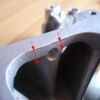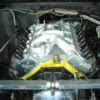A friend has given me a Torker intake to use and when I install it on the engine I see it tilts the carb forward a fair amount. I understand they do this for a mustang as the engine tilts back to achieve drive line angles. As the engine was not in the car when I got it I can't judge if the engine sits level (I am assuming it does). If the engine does sit level I could see some possible drivability problems with the carb tilted forward that much. Any thoughts?? Thanks
Original Post





